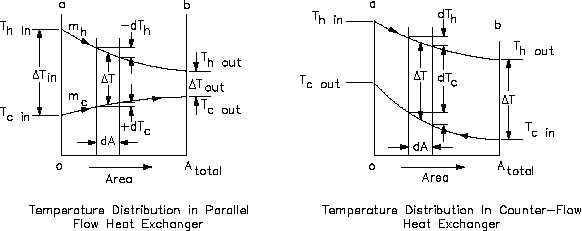Heat Transfer
HEAT EXCHANGERS
Figure 10 Heat Exchanger Temperature Profiles
The design of a parallel flow heat exchanger is advantageous when two fluids are required to be
brought to nearly the same temperature.
The counter-flow heat exchanger has three significant advantages over the parallel flow design.
First, the more uniform temperature difference between the two fluids minimizes the thermal
stresses throughout the exchanger. Second, the outlet temperature of the cold fluid can approach
the highest temperature of the hot fluid (the inlet temperature). Third, the more uniform
temperature difference produces a more uniform rate of heat transfer throughout the heat
exchanger.
Whether parallel or counter-flow, heat transfer within the heat exchanger involves both
conduction and convection. One fluid (hot) convectively transfers heat to the tube wall where
conduction takes place across the tube to the opposite wall. The heat is then convectively
transferred to the second fluid. Because this process takes place over the entire length of the
exchanger, the temperature of the fluids as they flow through the exchanger is not generally
constant, but varies over the entire length, as indicated in Figure 10. The rate of heat transfer
varies along the length of the exchanger tubes because its value depends upon the temperature
difference between the hot and the cold fluid at the point being viewed.
Rev. 0
Page 33
HT-02

